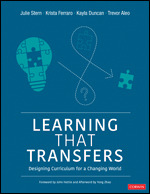Learning That Transfers
Designing Curriculum for a Changing World
Foreword by John Hattie, Afterword by Yong Zhao
Corwin Teaching Essentials
"It is a pleasure to have a full length treatise on this most important topic, and may this focus on transfer
become much more debated, taught, and valued in our schools." - John Hattie
Teach students to use their learning to unlock new situations.
How do you prepare your students for a future that you can’t see? And how do you do it without exhausting yourself? Teachers need a framework that allows them to keep pace with our rapidly changing world without having to overhaul everything they do.
Learning That Transfers empowers teachers and curriculum designers alike to harness the critical concepts of traditional disciplines while building students’ capacity to navigate, interpret, and transfer their learning to solve novel and complex modern problems. Using a backwards design approach, this hands-on guide walks teachers step-by-step through the process of identifying curricular goals, establishing assessment targets, and planning curriculum and instruction that facilitates the transfer of learning to new and challenging situations. Key features include
- Thinking prompts to spur reflection and inform curricular planning and design.
- Next-day strategies that offer tips for practical, immediate action in the classroom.
- Design steps that outline critical moments in creating curriculum for learning that transfers.
- Links to case studies, discipline-specific examples, and podcast interviews with educators.
- A companion website that hosts templates, planning guides, and flexible options for adapting current curriculum documents.
Using a framework that combines standards and the best available research on how we learn, design curriculum and instruction that prepares your students to meet the challenges of an uncertain future, while addressing the unique needs of your school community.
Free resources
Podcast: Engaging Kids in Learning Transfer with Julie Stern
In this Leaders Coaching Leaders podcast episode, Julie Stern talks about the importance of how teaching conceptual understanding can be a powerful way to engage students not only in learning, but in processing their own experiences.
Learning that Transfers is a rare combination of practical and inspirational. Drawing
together concepts from psychology, neuroscience, and the learning sciences, the
authors mount a case that transfer is one of the keys to designing curriculum that can
produce deep and durable learning for the 21st century. Educators everywhere will
welcome the book for its clarity, use-value, and timeliness.
Accessible. Reflective. Timely. Inspiring. Engaging. By asking all of the right questions,
this book enables teachers to navigate overwhelming numbers of outcomes by creating/
uncovering complex relationships between concepts and extending learning through
real-world transfer. I want education to help develop deep thinking, compassionate
humans, and this book supports this aim fully.
There is so much I love about this book. Learning That Transfers: Designing
Curriculum for a Changing World provides a step-by-step process that allows readers
to connect their learning and transfer it to the work they do. It is based in research
and practice.
This is a serious and ambitious book that makes explicit connections from a model
of learning right through to curriculum design and implementation. In doing so,
it provides the reader with an explicit structure that supports their progress as they
acquire, connect and transfer what they learn, demonstrating the efficacy of their
model of learning.
The authors have brilliantly captured the purpose of instruction today. Our students
MUST be able to acquire, connect and transfer knowledge and, as educators, we must
be intentional in our curriculum design to ensure that happens. This book is a great
resource for ALL 21st Century educators.
How might we design agile curriculum that prepares learners for a wildly unpredictable
world? How might we design learning experiences for a silo-free system, even as we
continue learning inside of them? The practical wisdom and tangible tools tucked into
every nook and cranny of this ground-breaking text make this the right book for the
right time, and these are the right people to learn from.
The book guides you from “what to WOW” in a clear and concrete way, offering a
multitude of strategies as a primer to design learning that transfers. Everything in it
has been tested with diverse students around the globe by educators like you. This
work is a promise for transformation in education with an abiding focus on student
ownership, complex thinking, and relevant learning.
The authors have advanced a critically important new synthesis of the science and
art of effective teaching. By focusing on the practical methods teachers can use to
help students engage deeper conceptual understanding, this book helps keep the big
questions about life, humanity, and sustainability in mind, even as we structure the
fine-grained details of everyday classroom lessons.
We live in a world of often bewildering particularities. Children begin thinking,
Vygotsky says, by assembling their immediate world into mental complexes where
particularities understood by their juxtaposition. With schooling, children learn to
organize the world by concepts or transferable patterns of meaning. The authors
of this important new book masterfully explore the way these two pivotal ideas—
concepts and their transfer—play out in educational practice.
In an increasingly neoliberal world of performance and accountability, this book is a
call-to-arms for anyone passionate about real learning. The “Try Next Day” strategies
would enhance any classroom because they complement what you do already.
